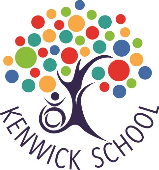
|
Kenwick School (6034)
|
School Overview
|
Kenwick School is a government Level 4 Education Support School serving approximately 80 students. The school serves a large catchment area from Byford to Kenwick and from Roleystone to Thornlie.
The majority of the students are bused to school on one of 5 school bus services.
The school purpose is to ensure that all Kenwick School students develop the knowledge, confidence and skills to acvhieve their potential and contribute to society. Students are aged from 4 to 18 years, from Kindergaretn to Year 12, and have a diverse range of support needs and abilities. Student have mild/moderate to profound intellectual disabilities. Some students have severe and multiple disabilities while others have vision and hearing impairments. About 20b0of students have an Autism Spectrum Disorder.
The school is staffed with one Teacher and approximately two Education Assistants for 11 classes including kindergarten and preprimary, Junior, Intermediate, Senior and Post-Compulsory classes. Class sizes will range from 5 to 11 students, depending on student needs.
Administration and office staff consist of a Principal, a Deputy Principal, a Level 3 Teacher, a full-time Registrar and a School Officer. Specialist teachers provide sport, Perceptual Motor Skills, work skills, music and Indonesian programs. Three qualified Social Trainers provide work experience support to post-compulsory students. Two qualified swimming teachers provide school-based and community-based swimming programs. Two Health Department nurses provide medical support and a range of Therapy Focus therapists and therapy assistants provide physiotherapy, occupational therapy and speech therapy services. The staff also includes a Library Officer, gardener and three cleaners.
All classes are multi-aged groups (MAG classes) with students from more than one year level. In general, students are grouped first by age and then consideration is given to ability level, academic attainment and physical needs. Cross setting is used for academic and non-academic programs to maximise learning time.
Each student has an Individual Education Plan that is developed in collaboration with all teaching and therapy staff and the students' families. IEPs are developed at the start of each semester and reporting to parents occurs at the end of each semester.
The school has two ovals, three fenced playgrounds for different age groups and two toilets designed to meet the needs of students, including those with multiple physical handicaps. The school also has a basketball/volleyball court, a fenced garden for student gardening projects and an indoor heated swimming pool. Other school facilities include a student library, a teacher resource library, a physiotherapy treatment room/mini gym for use by students, a fully equipped kitchen for student cooking sessions, a laundry for home care skills, an indoor recreation room which is used for motor programs and school assemblies, a Multi-Sensory Environment Room for sensory activities and a nurses' office and treament area.
The completely wheel-chair accessible school is composed of a 'main' building, a Manual Arts building for work skills and wood-working and 7 transportable classrooms; an 8th transportable is expected at the end of the 2004 school year. All rooms are air-conditioned and heated.
The school has a small but active P & C, a School Council and 16 in-school committees run by staff to address a range of school development issues. The committees include a Finance Committee, an Occupational Safety and Health Committee and committees for a range of curriculum areas. Most teaching and non-teaching staff carry additional responsibilities within the school and staff meetings involve input from many quarters.
Plans are being developed for a Student Council, to give students more opportunity to participate in school development.
|
|
|
|